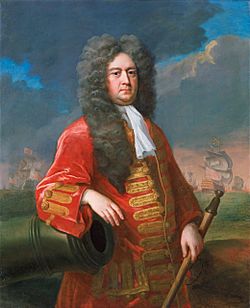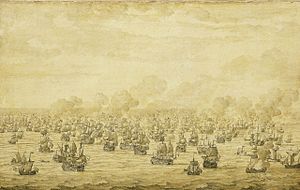George Rooke facts for kids
Quick facts for kids
Sir George Rooke
|
|
|---|---|

George Rooke by Michael Dahl painted c. 1705
|
|
| Born | 1650 St Lawrence, Canterbury, Kent, England |
| Died | 24 January 1709 (aged 58–59) St Lawrence, Canterbury, Kent, Great Britain |
| Buried |
St Paul's Church, Canterbury
|
| Allegiance | |
| Service/ |
|
| Years of service | 1672–1705 |
| Rank | Admiral of the Fleet |
| Commands held | HMS Holmes HMS Nonsuch HMS Hampshire HMS St David HMS Deptford Irish Squadron Mediterranean Fleet |
| Battles/wars | Third Anglo-Dutch War Nine Years' War Great Northern War War of the Spanish Succession |
Admiral of the Fleet Sir George Rooke (1650 – 24 January 1709) was an important English naval officer. He served in the navy for over 30 years. He fought in many major wars and battles of his time.
Rooke started his career as a junior officer. He fought in the Third Anglo-Dutch War. Later, as a captain, he helped Prince William of Orange travel to England. He also took part in the Battle of Bantry Bay.
As a senior officer, Rooke commanded parts of the Royal Navy. He fought in the Nine Years' War and the War of the Spanish Succession. He is famous for capturing Gibraltar and destroying the Spanish treasure fleet at Vigo Bay.
Contents

George Rooke was born in 1650. His father was Colonel Sir William Rooke. George joined the Royal Navy as a volunteer in 1672. This means he joined without formal training.
Later that year, he became a lieutenant. He served on the ship HMS London. He fought in the Battle of Solebay in May 1672. This battle was part of the Third Anglo-Dutch War. The British and French fleets fought against the Dutch.
In 1673, he moved to HMS Royal Prince. He fought again in the Battle of Schooneveld in June 1673.
Becoming a Captain
Rooke became a captain on November 13, 1673. He was given command of HMS Holmes. His job was to protect merchant ships. These ships carried goods across the sea.
After some time in the Army, Rooke returned to the navy. In 1677, he commanded HMS Nonsuch. He helped Prince William of Orange travel to England. This was an important journey.
He later commanded HMS Hampshire in the Mediterranean. Then he commanded HMS St David in the English Channel. In 1688, he commanded HMS Deptford. He fought in the Battle of Bantry Bay in May 1689. This battle was part of the Williamite War in Ireland. French ships tried to land troops in Ireland.
In August 1689, Rooke cleared Belfast Lough of French ships. This allowed Marshal Schomberg's army to land. They successfully attacked Carrickfergus.
Leading the Fleet

In 1690, Rooke was promoted to rear admiral. He commanded a part of the fleet at the Battle of Beachy Head. This battle was a French victory. Rooke's actions were questioned later. But he was found not guilty of any wrongdoing.
He became a vice-admiral in 1692. He served under Admiral Edward Russell. Rooke fought bravely at the Battle of Barfleur in May 1692. He then led a night attack on the French fleet at La Hogue. He managed to burn twelve enemy ships. For his bravery, he was made a Knight in 1693.
Later in 1693, he protected a group of merchant ships. These ships were going to Smyrna. French Admiral Anne Hilarion de Tourville attacked them. Many ships were captured. Rooke was promoted to full admiral in July 1693.
In 1694, Rooke joined the Board of Admiralty. This board managed the Royal Navy. He also became commander-in-chief of the Mediterranean Fleet. He returned to England in 1696.
He was then promoted to Admiral of the Fleet. He commanded the Channel Fleet. But he could not stop a French fleet from reaching Brest. He was criticized for this.
In 1698, Rooke became a Member of Parliament for Portsmouth. He spoke for the Admiralty in Parliament. In 1699, he became the Senior Naval Lord on the Admiralty Board.
In 1700, Rooke commanded an Anglo-Dutch fleet. They worked with a Swedish fleet. They attacked Copenhagen. This helped King Charles XII of Sweden land his army in Denmark. This was at the start of the Great Northern War.
In 1702, Rooke was appointed to the council of the Lord High Admiral. He also became Vice-Admiral of England.
Major Victories
The Allies planned to capture Cádiz in Spain. Rooke led this expedition in August 1702. But the attack on Cádiz did not go well. The mission was called off.
However, the English government learned about a Spanish treasure fleet. This fleet was in Vigo Bay. Rooke was told to capture it. In October 1702, his fleet attacked. The ship HMS Torbay led the charge. It broke through a barrier in the bay. Every French or Spanish ship was either captured or destroyed. This was the Battle of Vigo Bay. Rooke was thanked by Parliament for this important victory. It was a key moment in the War of the Spanish Succession.
In 1703, Rooke safely brought Archduke Charles of Austria to England. Archduke Charles was a claimant to the Spanish throne.
In August 1704, Rooke commanded the Allied naval forces. They arrived in Gibraltar. After a heavy attack by 22 ships, a landing party took Gibraltar. Rooke also attacked the French fleet at the Battle of Málaga later that month.
Later Life and Legacy
Rooke suffered badly from gout. This is a painful joint condition. He retired from the navy in January 1705 due to his health. He also left his political roles. He died at his home in Canterbury on January 24, 1709. He was buried at St Paul's Church in Canterbury.
In 2004, a statue of Rooke was unveiled in Gibraltar. This was part of the 300th anniversary of Gibraltar's capture.
Family Life
Rooke married three times. Around October 1684, he married Mary Howe. After she passed away, he married Mary Luttrell in January 1701. They had one son together. After Mary Luttrell's death, he married Catherine Knatchbull in January 1706.
Honours
The ship's badge of HMS Hogue was inspired by Sir George Rooke. It shows a chess rook on a blue background. This design came from his family's coat of arms.
Images for kids
-
Catherine Knatchbull, Lady Rooke, painted by Godfrey Kneller. She was Sir George Rooke's third wife.
See also
 In Spanish: George Rooke para niños
In Spanish: George Rooke para niños




